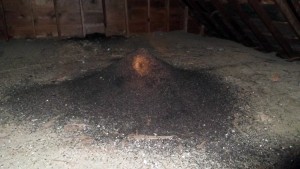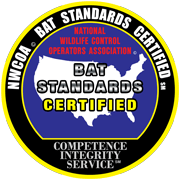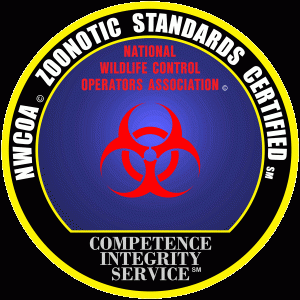Here in Iowa we deal mainly with big brown and little brown bats. The big browns are found in small colonies of 5-25, while the little brown are found in much large colonies into the hundreds. A bat exclusion process is needed to resolve any situation where a building, home, or structure is infested with this type of animal.
Iowa Wildlife Control is aware that there is a wealth of knowledge available on the internet in regards to bat control and health related issues with respect to human exposure to bats in general. Some general information on bats is very good however there is also some common “do it yourself” bat control information that we have viewed that is very inaccurate.
The point being from a professional stand point I would caution one as to the validity and effectiveness of some this information. The old saying that “all that glitters is not gold” stands true in this case. Anyone who would like to learn more about bats and research the problems that are associated with living in close proximity with them should be able to find the answers to many of their questions on the net.
It is our professional opinion that if you are not adequately satisfied with your research findings and you do not fully understand the facts, it would be our recommendation to contact a seasoned professional to help you understand more fully the things you wish to know.
Most homeowners make the mistake of sealing entrances and openings to prevent bats from gaining access into their structure, but in a many cases, they also seal areas that the bats are using to go out of the structure. When this is done it will force the entire colony of bats down through the living quarters of the house, which can be a very messy and dangerous situation.
Bat exclusions are needed to remove bats from buildings and structures. All of the cracks, holes, crevices, anything the size of a quarter inch or more are sealed, and then bats are funneled through one-way doors or tubes out of the structure. Our rule of thumb is “If you can slide a pack of matches into the crack or fit the tip of your little finger in the hole, a bat can get in there and it needs be sealed.” After this process is complete (a week to ten days) the whole colony has been removed, then the excluders are removed and those access points sealed as well.
Bat guano buildup can be hazardous to your health, it can breed Histoplasmosis , as well as leaving a foul odor to your attic that may leak down into your living areas. We wear mask and Tyvek clean suits when handling the guano and soiled materials, as well as sealing off the attic access and spraying disinfectant and deodorizers when we are finished. We also use anti-fungal encapsulation paints to not only lock in anything malodorous into the substrate but also provide long lasting mold inhibiting properties during clean-outs..
It is our purpose to educate and allow you to learn from our experiences, explain our views, exclusion methods and services that are available. Hopefully this will enlighten you to some of the more important concerns that we have involving bat colony exclusions. We feel it is very important for the consumer to have a better understanding of bat behavior in structures and the possible consequences of human exposure to bats and bat guano while co-existing in a residence or a working environment.
If we can be of assistance in helping you with questions or concerns with respects to your bat control needs, guano removal projects or odor control issues we will certainly be able to provide you with the facts as we know them. What effectively works and what is an effort in futility. Our consultation services will certainly enable you to make an educated and practical decision in resolving your bat infestation problems quickly and effectively.
If you wish to contact us with information regarding your bat problem you may do so by email iowawildlifecontrol@gmail.comwhich is monitored daily by our staff. Or if you would like to speak with one of our staff personally you may call us at 515-451-0843.
Iowa Wildlife Control can provide you with all of the resources available to us that come from the accumulation of knowledge from decades of field experience in wildlife control technology. I trust you have found our site to be very helpful, honest and educational. It has always been our policy to provide honest and factual information to those who need help and answers to their bat related problems.
We hold the following certifications from NWCOA (Nuisance Wildlife Control Operators Association)
One of the most common questions I am asked is, “If I put up a bat house in my yard, will the bats leave my attic and go live there?” The simple answer is NO they will not move to the bat house from your home. Here is how I explain it “You out up a bat house in your back yard expecting the bats to leave your nice climate controlled, dry, safe, house and go live in the new bat house you put up. If I put a nice shed in your back yard as well would you go live there rather than the home you’ve come to know and love? Of course not, and neither do the bats. Your home is their home and they like it and will come back year after year.
If you’d like us to install a bat house for you, we can but the odds of bats actually taking up residence is low, and the odds of them leaving your home to live there are zero!





